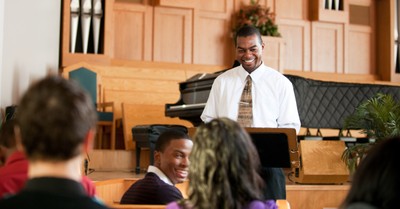Church 3.0
- Published Mar 01, 2023
Editor’s Note: The following is an excerpt from the just-released book by James Emery White, Hybrid Church: Rethinking the Church in a Post-Christian Digital Age (Zondervan). It’s available now from Amazon, Barnes & Noble, Christian Book Distributors, The Grounds Bookstore and Café, and bookstores nationwide. You can get more information HERE.
**********
It is time to put forward a simple but provocative thesis: the church must respond to the new reality of a post-Christian world and the digital revolution by becoming something it has never been before.
Church 3.0.
The church must respond this way, first, because of the rise of the nones and the post-Christian world we live in have changed our mission field entirely and, second, because the digital revolution has changed our means of communicating with that mission field. The significance of these changes cannot be overstated. When you look at the cultural challenge facing the mission of the church, regardless of the era, two key dynamics have always been at play: one is the nature of the mission field, and the second is the nature of communication needed to reach that mission field.
Imagine you are sent to reach an unreached people group, such as the Shaikh of Bangladesh. You first need to know something about the spiritual state of those people. What religious or supernatural beliefs do they hold? Have they been exposed in any way to the Christian faith? Understanding your mission field is understanding who you are trying to reach—economically, culturally, demographically, and especially spiritually. In this case, you find yourself in South Asia on the Bay of Bengal. The dominant religion of the Shaikh is Islam – they practice both Sunni and Shia traditions – and there are many subgroups within the Shaikh people group. Just that small snapshot tells you many things you need to know and do to prepare as a missionary. Next, you need to learn how to communicate with them. You need to learn their language – in this case, Bengali – and then convey the message of the Christian faith in a way that is both understandable and accessible.
Now let’s imagine you want to reach an entire culture, not just a particular people group. What can be said of the West as a mission field, and how have we historically communicated with Western culture? For example, is the climate Christian, anti-Christian, post-Christian? What is the spiritual context in which we are trying to operate? Is the culture literate and knowledgeable? If not, what is the nature of its illiteracy and ignorance? Then we must ask how people communicate with each other within that culture, which is key because that will determine how we must communicate the gospel. Have our theology and Scriptures even been translated into that language yet?
I would contend that there have only been three main eras in the roughly 2,000-year history of the church. The first era began with the birth of the church. Following Pentecost, the early church faced a largely pagan culture that used premodern modes of communication. What kind of church evolved to meet this challenge?
Let’s call it Church 1.0.
Church 1.0 was organic and communal. It met in homes and often faced persecution. Leadership was strong, authority was established, but structure was loose knit. Communication was almost entirely oral. Even when a letter from, say, the apostle Paul arrived, the custom was to read it aloud to the gathered church.
Evangelism was largely designed for Jews, Judaizing gentiles, and pagans. Churches networked with each other but largely focused on, and reflected, their immediate context. This is why the New Testament letters vary in content. The context at Corinth, for example, was vastly different than the context at Rome. But in all the churches, signs and wonders flowed relatively freely, particularly early on, authenticating the early proclamation of the gospel. When signs and wonders were combined with an emphasis on personal evangelism and service to the poor and vulnerable, the numbers of converts exploded. By AD 100, there were around 7,500 followers worldwide. By the mid-300s, more than 30 million called themselves followers of Christ.
Then everything changed.
The growth and influence of the Christian movement, particularly after the conversion of Roman Emperor Constantine in 310, transformed the West from a pagan culture to a Christian culture. But that wasn’t the only thing that changed. So did communication, which evolved from oral to written, and then to mechanized writing. How did the church respond? What kind of church emerged to meet the challenge of not only a changed spiritual context but also new forms of communication—to meet the challenge of going from persecuted minority to dominant cultural majority, and from an oral mode of communication to a written mode?
Let’s call it Church 2.0.
Church 2.0 spanned a long section of Christian history, from the early Middle Ages to the time known as the Enlightenment and to the modern era. While much changed in the West during that time, one thing did not: the centrality of the church and the Christian faith. What this meant was that rather than contending for Christ in a marketplace of ideas, as well as in the face of persecution, the Western church operated in a context of cultural dominance, if not outright control.
As for communication, the Scriptures were canonized and their propagation was confined to written language—Hebrew, Greek, Latin, and eventually German, English and other languages. This meant that communication shifted from primarily oral to primarily written, and then it became mechanized. It should be no surprise that the very first book off Gutenberg’s revolutionary moveable-type printing press in 1454 was a Bible.
We are now living in the aftermath of a seismic change as Western culture completed its shift from Christian to post-Christian. The church and the Christian faith had a tight grip on culture for more than a thousand years, and the shift from sacred to secular, from Christian to post-Christian, took from the Enlightenment era until now to take place. And communication has shifted from mechanized writing to electronic encoding. We are now living in a post-Christian digital world. What kind of church will meet the challenge of this new day?
Let’s call it Church 3.0.
Church 3.0 embraces the new post-Christian digital terrain. Knowing that you’re trying to reach a post-Christian world, not pre-Christian or Christian, and knowing that you have to do it digitally is a paradigm shift of seismic proportions. And change has happened so fast that we’re having to, as they say, fly the plane while we build it. This third missional era has come into being in a historical nanosecond. We live in a profoundly different context than we did even twenty years ago, which is why it is so important for the church to wake up immediately to a new set of realities. Do you know the analogy of the frog in the kettle? If you place a frog in a pot of water and slowly warm the temperature of the water to a boiling point, the frog won’t notice that the water has become too hot until it’s too late. The frog will be dead before it knows to jump out. This illustration was often used to waken churches to the slowly warming waters of cultural change. But our situation is more akin to a frog in a microwave. We’re not easing into this. It’s not a gradual change. It’s been abrupt, which means we have to adapt quickly. We simply can’t do church in a 1.0 or 2.0 way anymore.
But we can do Church 3.0,
… and that means going hybrid.
James Emery White
Sources
This has been excerpted from James Emery White, Hybrid Church: Rethinking the Church in a Post-Christian, Digital Age (Zondervan), order here.
About the Author
James Emery White is the founding and senior pastor of Mecklenburg Community Church in Charlotte, NC, and a former professor of theology and culture at Gordon-Conwell Theological Seminary, where he also served as their fourth president. His latest book, Hybrid Church: Rethinking the Church for a Post-Christian Digital Age, is now available on Amazon or from your favorite bookseller. To enjoy a free subscription to the Church & Culture blog, visit churchandculture.org, where you can view past blogs in our archive, read the latest church and culture news from around the world, and listen to the Church & Culture Podcast. Follow Dr. White on Twitter, Facebook and Instagram at @JamesEmeryWhite.
The views expressed in this commentary do not necessarily reflect those of CrosswalkHeadlines.
James Emery White is the founding and senior pastor of Mecklenburg Community Church in Charlotte, NC, and a former professor of theology and culture at Gordon-Conwell Theological Seminary, where he also served as their fourth president. His latest book, Hybrid Church: Rethinking the Church for a Post-Christian Digital Age, is now available on Amazon or from your favorite bookseller. To enjoy a free subscription to the Church & Culture blog, visit churchandculture.org where you can view past blogs in our archive, read the latest church and culture news from around the world, and listen to the Church & Culture Podcast. Follow Dr. White on X, Facebook and Instagram at @JamesEmeryWhite.



















